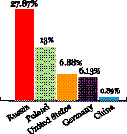Exports to big markets declined
In major economies exports have decreased
Mahfuz Emran: In the recently concluded fiscal year, the export of Bangladeshi products to major economies like USA, China, Germany, Poland, Russia has significantly decreased. Hopefully, the export growth in countries like Japan, Australia, Canada, Netherlands etc. is quite good. However, growth in non-conventional products remains negative.
As opposed to product exports, the bulk of the money earned comes from 15 countries in Europe, America and Asia. Of this, $1 billion or more than that comes from 12 countries. These countries are – USA, Germany, UK, Spain, France, Italy, Netherlands, India, Japan, Poland, Canada and Australia. Among these countries, only the United States, Germany and Poland saw a decline in exports. Exports outside the US-Europe have declined to China and Russia.
According to the Export Promotion Bureau (EPB), Bangladesh exported goods worth $5,556 million in the fiscal year 2022-23. And the top 12 countries have products worth $4,204 million. In the fiscal year 2021-22, these markets exported products worth $4,110 million. Exports to these countries increased by more than $193 million in one year. However, the United States, China, Russia, Germany, Poland have recorded negative growth of 6.88 percent, 0.89 percent, 27.87 percent, 6.13 percent and 13 percent respectively.
The United States is the largest market for country-made garments. 88 percent of the country’s total exports come from ready-made garments. In the fiscal year 2021-22, for the first time, exports to the US market exceeded $10 billion. However, exports fell to $9.7 billion in the last financial year, which is about 7 percent less than the previous year.
European country Germany is said to be the second largest market for Bangladeshi products. In the fiscal year 2022-23, the country exported goods worth $7.08 billion, which is about 7 percent less than the previous year. In the financial year 2021-22, this market exported products worth $7.59 billion. Readymade garments accounted for 94 percent of total exports to Germany in fiscal 2023. The value of which is about $668 million. And the second highest export is home textile products.
In the fiscal year 2022-23, China exported goods worth $6.77 billion, which is 0.89 percent less than the previous year. In the financial year 2021-22, the country exported goods worth $683 million. In the last financial year, the country exported ready-made garments worth $2.89 billion, home textiles worth $7 billion and plastics worth $11 billion.
Exports to Russia and Poland also fell due to the effects of the war in Europe. Poland exported goods worth $1.85 billion in the 2022-23 fiscal year, down 13 percent from the previous year. In the fiscal year 2022-23, exports of goods to Russia amounted to $4.6 billion. The main staple exported to the country is knitwear. The entrepreneurs of the country have exported $425 crores worth of ready-made garments to the country during the period under discussion. Although the total export earnings of 2022-23 fiscal year is 27.87 percent less than that of 2021-22 fiscal year.
In addition, the UK market has exported goods worth $5.31 billion, which is 10 percent more than the fiscal year 2021-22. $3.68 billion worth of products have been exported to Spain, another European country. Export growth in the country has been 16.33 percent.
Although the United Kingdom has left the European Union (EU), Bangladesh’s exports to the country have not decreased. Last fiscal year, the country had the third highest exports of goods worth $5.31 billion, which is almost 10 percent higher than the previous fiscal year. At that time i.e., in 2021-22 fiscal year, exports to UK were worth $4.82 billion. The top three exports in the market are ready-made garments at $503 million, home textiles at $80 million and frozen shrimp at $46.5 million. 97% of Spain’s total exports are made up garments.
Against the export of $3.29 billion in the French market, the growth was 21 percent. $239 crores in Italy and $209 crores in the Netherlands. Out of which 40 percent of exports to Italy and 18 percent to the Netherlands have increased.
India’s exports grew by 7 percent, with exports worth $213 million. In the fiscal year 2022-23, products worth $190 million were exported to Japan, $172 million to Canada and $126 million to Australia. Exports to Japan increased by 40 percent, Canada by 13 percent and Australia by 37 percent.
An analysis of EPB data shows that 84.57 percent of the total exports in the recently concluded fiscal year were garments. A review of major commodity-wise exports shows that eight commodities accounted for 93.73 percent of the total export earnings in the fiscal year 2022-23. The products are – Woven garments, knitwear (61), home textiles, frozen and live fish, agricultural products, jute and jute products, leather and leather products and footwear and engineering products. These products have exported $5,207 million.
When asked, the owner of Fatullah Apparels, Fazle Shamim Ehsan, told Daily Industry that China and Russia are new markets for us. America is our traditional market. America, UK and EU are our main markets. America’s economy is floundering, they are under pressure. Interest rates are very high there due to fiscal policy. Due to this, people have reduced the cost there. Our exports have not increased due to their reduced purchases.
He said, China is trying to reduce imports after Covid, Expanding their own market. But it won’t last long. We hope to get the Chinese market back. If the global economic situation is correct, we can do better from the China market. Everyone knows that our influence in the Russian market has decreased because of the war.
“Due to the war, we are dealing with knitwear, woven garments, plastic products, caps, tobacco, paper and paper products, electronics products, footwear (except leather), powdered spices, leather products, ceramic products, wigs and human hair, live There has been an increase in exports of fish, cement, ships, tea etc. And Special Textiles, Vegetables, Petroleum By-Products, Medicines, Fruits, Handicrafts, Furniture, Carpets, Shrimps, Rubber, Knit Fabrics, Bicycles, Copper Wire, Engineering Parts, Dry Foods, Jute Yarn & Twine, Crabs, Terry Towels, home textiles, raw jute, chemical products, jute socks and bags, leather shoes, leather, golf soft etc. products witnessed negative growth.’
In the outgoing fiscal year 2022-23, apparel exports were worth $4,699 million. Out of which knitwear is $2,321 million and oven clothing is $2,125 million. This export is 31.38 percent more than the fiscal year 2021-22. Plastic-melamine products worth $209 million were exported during the reporting period, which is 26.23 percent higher than the previous year.
Besides, 32.47 percent in home textiles, 1.73 percent in leather products, 26.26 percent in frozen and live fish, 27.47 percent in agricultural products, 7 percent in medicines, 19.10 percent in raw jute and jute products, bicycles 15.31 percent, engineering products showed a negative growth of 26.37 percent.
Bonded warehouses, tax rates, port exemption facilities are given to these growing sectors including apparel sector. Besides, incentives and subsidies are also given to traders. There are compliance issues in agriculture and processed products. There are strict international standards and hygiene matters. Due to this, if these products are not of international standards, there is a problem in export. No initiative or roadmap for international certification has been taken. Agro-processed products have great potential. Because its main raw material is available in our country. Same goes for leather goods. If we can fix the quality of these products, our export basket will be richer.
Research Institute Research and Policy Integration for Development (RAPID) chairman and economist Dr. Mohammad Abdur Razzak thinks that there is no alternative to expand the product in non-traditional markets to increase export income.
He said, there is less opportunity to call India-Australia an unconventional market. Because I have been doing well in these markets for a long time. On the other hand, China is a non-traditional market for Bangladesh. Other countries in the Middle East and Latin America are doing well. We have to capture these markets if we want to go ahead with exports.
Rare Israeli airstrike in Beirut kills Hezbollah commander and more than a dozen others
International Desk: Israel launched a rare airstrike that killed a senior Hezbollah milita…








